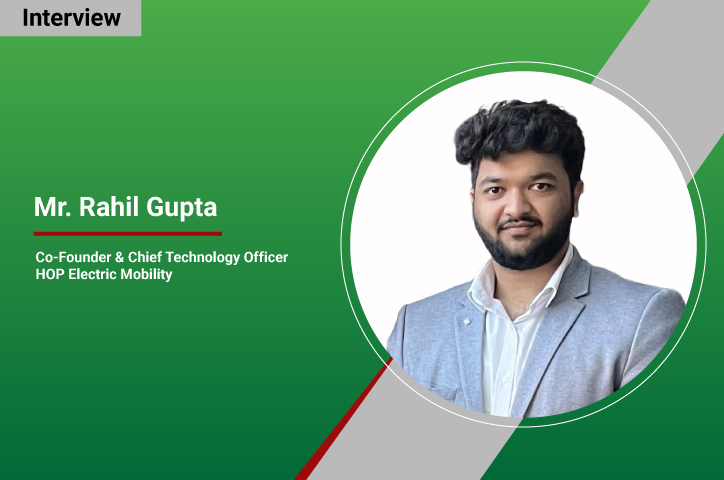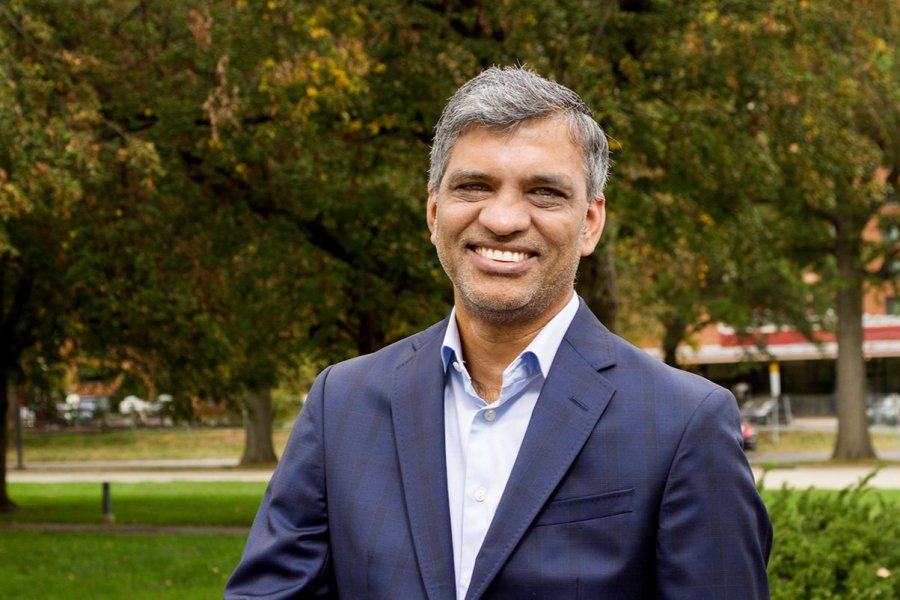A recent report from Bain & Company projects that Electric Vehicles (EVs) could account for more than 40% of India’s automotive market and generate over $100 billion of revenue by 2030. Given that the current share of EVs in Indian market is 5%, this projection points to a phenomenal 8X growth. This is being driven by strong adoption (45%+) in both two-wheeler and three-wheeler categories.
In today’s interview, we are in conversation with Mr. Rahil Gupta, Co-Founder & Chief Technology Officer of HOP Electric Mobility- an organization that envisions transforming India's EV landscape with accessible and affordable mobility solutions. Founded in January 2019, the Jaipur based company boasts a successful portfolio of three electric two-wheelers: LEO and LYF e-scooters, and the OXO e-motorcycle. Their HOP Nuron connected stack for the OXO motorcycle showcases exclusive features, reflecting the company's commitment to innovation. In line with government’s Production Linked Incentive (PLI) scheme, the company has also earmarked an investment of Rs. 1,000 crore to establish the country's first integrated EV Park in Neemrana with the first phase of work already underway.
HOP Electric Mobility's rise aligns with the broader surge in India's EV industry. The company aims to become the most trusted brand by offering feature-packed, competitively priced vehicles while fostering sustainability at the same time. As India propels towards EV sales penetration targets, HOP Electric's strategic initiatives signify a compelling step towards a sustainable and electrifying future.
Scroll down to read the full interview:
Q. Please tell us about vision behind HOP Electric Mobility and give us an idea of its operations.
A. We founded HOP Electric in January 2019 as an integrated electric mobility company having a comprehensive ecosystem approach to the electric vehicles business. The vison was to create products which can give accessible and affordable mobility solutions to a large part of India.HOP Electric started with a regional branch in Jaipur. As of now, our portfolio includes three EV 2-wheelers running in the market successfully, with more than 15,000 units on road: two e- scooters (LEO and LYF) and an e-motorcycle (OXO), offered in different variants.
At HOP Electric Mobility, our line-up of e-2Wheelers are based on extensive R&D and engineering. They have exclusive features that are not so prevalent in the currently available vehicles in the market, e.g. – In our connected stack named HOP Nuron for OXO – our high-speed electric motorcycle,customers have dedicated support features in the application. They can call an RSA, book a service, or find a charging station/service station in the Nuron Mobile App. HOP Nuron connected platform also enables us to run a remote diagnosis and over-the-air support.
To sum up, from offline to online we are ensuring a good ownership experience to all our customers. To accelerate the vision of propelling electric mobility adoption in India, we are developing a first-of-its- kind scheme in the electric vehicle segment called the HOP Infinity Energy Network. In fact, the pilot network with 5 Swapping stations and 50 batteries is currently operational in Jaipur, and is now being further expanded to other cities and states.
We are the successful mandate holders of the Government of India's (GOI) Production Linked Incentive (PLI) scheme for Auto under the New Non-Automotive Investor (OEM) category. Under this mandate, we will be investing more than INR 2000 crore in India in the next five years. The goal is to bolster India's manufacturing capacities and boost HOP Electric's ambitions of becoming a global energy mobility pioneer.
Q. You aspire to establish HOP Electric Mobility as the most innovative, feasible and trusted electric vehicle brand for age groups. What are the plans and strategies in place that will help you achieve this goal?
A. As I mentioned above, our e-vehicle solutions are based on extensive R&D. The vehicles are feature packed, which set them apart from other vehicles in the market-- this includes High Range upto 125 km, 72V architecture, connected features (Internet, GPS, Mobile App, Geo-Fencing, predictive maintenance & diagnostics) and many more.
- Our portfolio of e2Ws save up to 90% on fuel costs compared to conventional ICE counterparts. Moreover, the vehicles are very attractively priced, after we had reduced prices across our product line-up : OXO's prices were reduced to Rs. 1.48 lakh ex-showroom, while HOP LEO e-scooter which comes in High-Speed registered and low-speed non-registered variants – the prices were revised to Rs. 97,500/- and Rs. 84,000/, respectively. HOP LYF, which comes in low-speed non-registered, is priced at Rs. 67500/.
- Further to accelerate adoption, we offer easy financing options – e.g. extending up to 100% financing facility on our highly sought-after OXO e-motorcycle to make sustainable urban mobility more accessible.
- In addition to above, we offer connected features and Intelligence in our vehicle which translates to better experience in this digital first world.
Q. You want to become a brand that assists customers in becoming more independent, technology-savvy while being environmentally friendly. Could you shed some light on how do you plan to be environmentally friendly and help your consumers towards the same?
A. The most important aspect – We have developed comprehensively Safe EVs for our discerning customers – undertaken backward-integration and further re-engineered quality standards for Testing & Validation of battery packs, wherein we place a lot of emphasis on our thermal management design, mechanical strength of pack, smart monitoring & control using Intelligent BMS (Battery Management system) and proprietary algorithms.
We test our vehicles and battery packs at extreme discharge rates and high ambient temperatures, up to 50 degrees Celsius. Each of our utilised components, including cells, is rigorously verified for mechanical and electrical safety and is evaluated throughout its lifespan using simulated time-lapse systems. Making sure the battery performs effectively in automotive applications for consumers with high demands is the objective.
We also create circular value chains for generation- consumption-disposal of our core subsystems like batteries, powertrain and other components. For example, Our batteries are developed with best practices such as using clean energy, using sustainable packaging, and transporting via short distance to save on energy consumption. Then we have in house operations which we try to function in minimum energy required. Then after consumption of battery by customer, we repurpose the pack to Energy storage application, if it can be used there, else we send it for recycling where the precious metals are extracted to 96% effectiveness.
Q. In the current scenario, there are expectations from businesses to not only conduct business in a responsible manner but also fulfill social and environmental obligations. Are there any CSR or sustainability initiatives that you would like to share with us?
A. We have started afforestation drives across geographies we are present at to increase awareness of sustainability and think long term in case of climate change.
- We also have started to use green products and solution in our operations like using solar powered clean energy, using lesser distances for transport, using E-3w for movement of goods, subsidizing employee travel to electric 2W’s, using Inflector products to reduce cooling load inside buildings.
Q. 'Engineering for a Sustainable Future' was the theme of the "National Engineers Day". What progress has your company made in this direction?
A. This year, themed around 'Engineering for a Sustainable Future', we acknowledge the pivotal role engineers play in addressing pressing global climate concerns. India's aim to achieve Electric Vehicle sales penetration of 30% of private cars and 80% of 2 & 3-wheelers by 2030, has put adoption of Energy Efficient Mobility as priority across industry stakeholders.
Achieving climate goals can only be ensured with a collaborative approach and continuous advancements in technology driven by emerging engineering talent. It is imperative to recognize and celebrate this talent as we commemorate Engineer's Day, an occasion to explore and foster possibilities for future innovations. In alignment with India's vision of 'Atma Nirbhar Bharat', which will be incomplete without the contribution of the country's rich engineering talent, we have expanded our manufacturing capabilities to produce up to 1.80 lakh units per year, delivering cutting-edge 'Made in India' electric two-wheelers. The HOP Megaplex, run and managed by a team of over 100 highly skilled and qualified engineers, is a testament to our commitment to this cause.
Furthermore, in line with the government's Production Linked Incentive (PLI) scheme, we had earmarked an investment of Rs. 1,000 crore to establish the country's first integrated EV Park in Neemrana – on which the first phase of the work is already under way. This investment is a significant step towards driving India's transition to a sustainable future.
Q. While the EV will somehow address the climate concerns, the hazardous lithium-ion batteries are detrimental to environmental health, their disposal being the biggest challenge. What plans do you have to address this issue?
A. As mentioned above, we have our partners where after 75% State of Health (SOH), the battery pack is removed from Electric Vehicle and goes to Energy storage system, post 40-50% SOH, this pack will go into recycling where the precious metals like Nickel, Magnesium, Cobalt, Lithium, Aluminum, and Graphite will be extracted in form of Black mass to process further and move back to value chain in order to create new cells for EV and other applications.
Also, In India we consume a lot of Portable electronics, which have these precious metals inside, if we can create a good recycling industry here, we can be rich in these metals for further production and lower our dependence for imported or mined metals.
I call this phenomena, Urban Mining.
Q. Do you think we should focus more towards biofuel or hydrogen-based solutions now?
A. Given the urgency of the climate crisis and the need to reduce greenhouse gas emissions, it is imperative that we explore alternative energy sources that are cleaner and more sustainable than fossil fuels. Biofuel and hydrogen-based solutions are two promising options that have the potential to meet our energy demands while minimizing environmental impacts. They are two viable alternatives to fossil fuels that can help us address the climate crisis and achieve energy security. However, they also have some limitations, particularly in case of hydrogen – the element of cost, lack of infrastructure and difficulty in delivering hydrogen to customers, that needs to be overcome through research and innovation.
In addition to that, we do have some good advancements in Bio fuels, our country produces a lot of Agri-waste which can be efficiently converted into Bio CNG and Bio Diesel. This is a good short to medium term solution we should leverage upon as most of our Import bills are crude Oil for consumption.

















.jpg)




